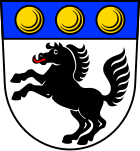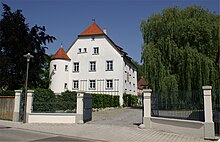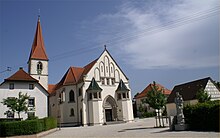Allmendingen (Württemberg)
| coat of arms | Germany map | |
|---|---|---|

|
Coordinates: 48 ° 20 ' N , 9 ° 43' E |
|
| Basic data | ||
| State : | Baden-Württemberg | |
| Administrative region : | Tübingen | |
| County : | Alb-Danube district | |
| Height : | 518 m above sea level NHN | |
| Area : | 45.91 km 2 | |
| Residents: | 4439 (December 31, 2018) | |
| Population density : | 97 inhabitants per km 2 | |
| Postal code : | 89604 | |
| Primaries : | 07391, 07384 | |
| License plate : | UL | |
| Community key : | 08 4 25 002 | |
| Community structure: | 5 districts | |
| Address of the municipal administration: |
Hauptstrasse 16 89604 Allmendingen |
|
| Website : | ||
| Mayor : | Florian Teichmann | |
| Location of the community of Allmendingen in the Alb-Donau district | ||
Allmendingen is a municipality in the Alb-Donau district in Baden-Württemberg, about 25 kilometers west of Ulm and four kilometers north of the large district town of Ehingen (Danube) .
geography
location
The core town of Allmendingen is located on the Schmiech in a valley originally washed out by the Urdonau , which separates the Hochstrasse to the east from the rest of the Swabian Alb . The highest point on the Lutheran Mountains (Ennahofen) is 750 m above sea level. NN .
Neighboring communities
The community borders on the town of Schelklingen in the north, on Altheim in the east, and on the town of Ehingen in the south and west . The Niederhofen exclave borders the city of Erbach to the north and east, and Oberdischingen and Öpfingen to the south.
Community structure
The municipality of Allmendingen consists of the suburbs Allmendingen (3399 inhabitants on December 31, 2019), Ennahofen (266 inhabitants), Grötzingen (260 inhabitants), Niederhofen (379 inhabitants) and Weilersteusslingen (245 inhabitants). The suburbs of Allmendingen include the districts Großallmendingen , Kleinallmendingen and Schwenksweiler , the hamlet of Hausen ob Allmendingen and the Siegentalhof farmstead. Only the villages of the same name belong to the sub-towns of Ennahofen and Grötzingen. The hamlets of Niederhofen, Pfraunstetten and Schwörzkirch and the Ziegelei homestead belong to the Niederhofen suburb . This suburb is an exclave because between its area and the rest of the Allmendingen municipal area there is a strip belonging to the city of Ehingen. The hamlet of Weilersteusslingen and the hamlet of Ermelau belong to the hamlet of Weilersteusslingen .
In the municipality there are several abandoned , no longer existing villages. The Augsdorf desert lies in the Allmendingen district north of Hausen . A lost castle is also suspected on the Waffensberg . In the district of Grötzingen are the deserted Hohenbuch , which was first mentioned in 1152 as Hohonbuach , and Kaltinwil , which was first mentioned around 1200 as Caltiwil . Hohenbuch is no longer mentioned in the 13th century and Kaltinwil in the 14th century.
history
antiquity
The earliest evidence of human settlement is the discovery of a brick kiln from the time of the Roman occupation in the Niederhofen district.
middle Ages
In the High Middle Ages, the area belonged to the Duchy of Swabia . 961 the place was called as Alamuntinga. A local nobility in Allmendingen was mentioned for the 12th and 13th centuries. Allmendingen Castle was located east of the Häusleberg (or Heilenberg) . In 1343 Allmendingen passed from the Counts of Berg to the Swabian foothills of the Habsburgs , who lent it to various noble houses as feudal lords.
Modern times
From 1520 Allmendingen belonged to the imperial fief of the Lords von Renner, who in 1593 sold their shares to the city of Ehingen , which guaranteed that Allmendingen remained Catholic. In the same year Ehingen sold the von Renner fief to Hans Walter von Freyberg zu Altheim. Since then, a lineage of the von Freyberg-Eisenberg family has determined the fate of Allmendingen. The two local castles also go back to the time of the rule of the Barons von Freyberg-Eisenberg .
With the Peace of Pressburg in 1805, Allmendingen fell to the Kingdom of Württemberg . In 1810 Allmendingen was subordinated to the Oberamt Ehingen . With the construction of the Danube Valley Railway , Allmendingen was connected to the Württemberg railway network in 1869 . During the district reform during the Nazi era in Württemberg , Allmendingen came to the district of Ehingen in 1938 . In 1945 Allmendingen became part of the French occupation zone and thus came to the newly founded state of Württemberg-Hohenzollern , which was incorporated into the state of Baden-Württemberg in 1952. Since the district reform in Baden-Württemberg in 1973, Allmendingen has been part of the Alb-Donau district .
Incorporations
On January 1, 1974, Ennahofen , Grötzingen , Niederhofen (with Schwörzkirch ) and Weilersteusslingen were incorporated.
Population development
These are population numbers according to the respective territorial status. The numbers are census results (¹) or official updates from the Baden-Württemberg State Statistical Office (only main residences ).
|
|
Religions
Allmendingen has always been shaped by Catholicism. The parishes of the Assumption of Mary in Allmendingen and St. Stephanus in Schwörzkirch belong to the Ehingen-Ulm deanery of the Rottenburg-Stuttgart diocese .
The old Württemberg districts of Weilerstreusslingen, Ennahofen and Grötzingen of the former rule of Steusslingen have traditionally been Protestant since the Reformation and, as a parish of Weilersteusslingen, belong to the Blaubeuren church district of the Evangelical Church in Württemberg .
In 1963, evangelical residents who moved in, also established their own evangelical parish in Allmendingen, which also includes the evangelical residents in Großallmendingen, Kleinallmendingen, Niederhofen, Pfraunstetten, Schwörzkirch and Altheim .
politics
Administrative community
Allmendingen forms an agreed administrative community with Altheim .
Municipal council
The municipal council in Allmendingen has ten members. In the local elections on May 26, 2019 , the local council was elected by majority vote. Majority voting takes place if no or only one nomination has been submitted. The applicants with the highest number of votes are then elected. The municipal council consists of the voluntary councilors and the mayor as chairman. The mayor is entitled to vote in the municipal council.
coat of arms
Blazon : "In silver under a blue shield head, in it three golden balls (loaves), a black, red-tongued, rising horse."
The coat of arms combines elements of the coat of arms of the Lords of Freyberg (spheres), whose history is closely connected with the Allmendingen, and the middle-class Renner family (horse), who also owned property in Allmendingen.
Town twinning
- Allmendingen near Bern ( Switzerland ) since 1978
- Querqueville (hamlet of Cherbourg-en-Cotentin , France ) since 1981
economy
traffic
Allmendingen is on the Ulm – Sigmaringen railway line and is a regional train stop. There are hourly train connections to Ehingen and Ulm. Allmendingen is part of the Donau-Iller local transport network .
The community is located on the federal road 492 Ehingen - Blaubeuren , which leads around the town center.
Established businesses
The largest employer is the automotive supplier Burgmaier . Other industrial companies are the mold manufacturer Rampf, which claims to be the world market leader in its sector, and the Schwenk cement plant, which also shapes the appearance of the town.
Leisure and sports facilities
Allmendingen was the first municipality in the area to have an outdoor swimming pool before the city of Ehingen. There is also a tennis court, a gymnasium and sports hall and the TSV Allmendingen football stadium .
Development of the municipality area
Incorporations
On January 1, 1974, the previously independent communities Ennahofen, Grötzingen, Niederhofen and Weilersteusslingen were incorporated.
Town center redevelopment
The community of Allmendingen has been renovating its town center since 2000. In addition to public, private measures are also funded. Within the renovation section I, the old school building , built in 1885, was converted into a community center. The state of Baden-Württemberg provided a total of 1.68 million euros in grants for the first phase of renovation. This corresponds to a funding of 60% from eligible total costs of 2.8 million euros. With these funds, public and private measures were used to remedy urban development deficiencies and grievances and to improve living, working and housing conditions in the town center.
The following public construction sections were realized:
- Northern Main Street (2001/2002)
- Church Square (2003)
- South Main Street (2004)
- Design of the town hall square (2006)
Community Marketing
Since 1998 there has been a community marketing working group in Allmendingen, an association of committed and interested citizens from the community. Community marketing wants to be a bridge between local government, trade and industry, local associations and citizens.
Culture and sights
Buildings
- Parish church of St. Maria Himmelfahrt from the 15th century
- Castle of the Barons of Freyberg , 16th century. The Barons von Freyberg-Eisenberg have been based in Allmendingen for hundreds of years and play an important role in Allmendingen's local history. For Upper Swabia and the Allgäu, von Freyberg took over the boiler protection , the jurisdiction over the traveling people . The old castle, a moated castle with two corner towers and a drawbridge, dates from around 1593. The new castle, which stands on the other side of the Kleine Schmiech and is connected to the old castle by a corridor, was built in 1782. The three-wing complex with a two-story central building under a mandrel roof and arcaded wing structures is built back inside the park. The chapel with epitaph is attached to the north wing, as well as commercial buildings such as the hunter's house on the main street, the gardener's house in the park, the barn and the mill, which today serves as a castle restaurant with an open terrace. The park behind the castle was only created in the last third of the 19th century. The Kleine Schmiech flows through it. The facility on Hauptstrasse in Großallmendingen, surrounded by a wall, is inhabited by the von Freyberg family. In the parish church of the Assumption of Mary you can see a death shield and a mansion bench decorated with a coat of arms.
- Bürgerhaus, former schoolhouse from 1887, expanded in 1895. It served as a school building until 1976. 2006 Renovation and use of the former schoolhouse as a community center with a large hall and several event rooms.
societies
- The local group Weilersteusslingen of the Swabian Alb Association , founded in 1913, was awarded the Eichendorff plaque in 2013 .
Regular events
- Local festival “Fest im Zentrum”, or FiZ for short
- Gökelesfest
- Night move
- Christmas Market
- Book flea market (one of the largest in southern Germany)
- Allmendinger Health Days
Personalities
Honorary citizen
The municipality of Allmendingen has granted the following people honorary citizenship:
- Anton Hoch (factory director) (1842–1919), director of the cement factory of the Stuttgart real estate and construction business in Allmendingen, honorary citizen on November 21, 1913
- Carl Schwenk (1852–1942), owner of the Schwenk cement factory in Allmendingen, honorary citizen November 1897
- Carl Schwenk (junior) (1883–1978), sole owner of E. Schwenk Zementwerke GmbH, Ulm (Donau), honorary citizen on October 26, 1952
- Dr. Eberhard Schleicher (1926–2007), owner of E. Schwenk Zement KG, Ulm (Donau), honorary citizen 1982
Sons and daughters of the church
The following overview contains important personalities born in Allmendingen, listed according to the year of birth. For the naming it is irrelevant whether the persons later had their sphere of activity in Allmendingen or not.
- Joseph von Sontheimer (1787–1846), Royal Wuerttemberg General Staff Doctor, translator of the Arabic remedy recipes from Avicenna
- Albrecht von Freyberg (1876–1943), naval officer, vice admiral of the Reichsmarine, naval attache
- Helmut Braig (1923–2013), painter, sculptor, graphic artist, filmmaker and book author
- Johannes Kopp (1927–2016), theologian and Christian Zen teacher
- Ernst Geprägs (1929–2011), born in the Grötzingen district, farmer, Vice President of the German Farmers' Association
- Ernst von Freyberg (* 1958), lord of the castle of Allmendingen , head of the Vatican Bank in Rome (2013-2014)
- Margit Hudelmaier (* 1960), social worker and former chairwoman of the Federal Association of Thalidomide Victims
- Nico Drmota (* 1979), basketball official
Other personalities
Well-known personalities are listed here who have spent part of their life in Allmendingen or who died in Allmendingen.
- Adolf Waas (1890–1973), librarian, historian and educator
- Karl Friedrich Ritter (1900–1986), poet, head of the elementary school in Allmendingen
literature
- Community Allmendingen (Ed.): Allmendingen: A home book for the millennium celebration . Süddeutsche Verlagsgesellschaft, Ulm 1961.
Web links
Individual evidence
- ↑ State Statistical Office Baden-Württemberg - Population by nationality and gender on December 31, 2018 (CSV file) ( help on this ).
- ↑ Statistical information 2019 , on allendingen.de
- ^ The state of Baden-Württemberg. Official description by district and municipality. Volume VII: Tübingen administrative region. Kohlhammer, Stuttgart 1978, ISBN 3-17-004807-4 . Pp. 308-397
- ^ Ulrich Brandl and Emmi Federhofer: Ton + Technik. Roman bricks. Theiss, Stuttgart 2010, ISBN 978-3-8062-2403-0 ( publications from the Limes Museum Aalen. No. 61)
- ^ Federal Statistical Office (ed.): Historical municipality directory for the Federal Republic of Germany. Name, border and key number changes in municipalities, counties and administrative districts from May 27, 1970 to December 31, 1982 . W. Kohlhammer, Stuttgart / Mainz 1983, ISBN 3-17-003263-1 , p. 542 .
- ↑ Population development in Baden-Württemberg from 1871 to 2012 ( Memento from September 7, 2014 in the web archive archive.today )
- ^ Federal Statistical Office (ed.): Historical municipality directory for the Federal Republic of Germany. Name, border and key number changes in municipalities, counties and administrative districts from May 27, 1970 to December 31, 1982 . W. Kohlhammer, Stuttgart / Mainz 1983, ISBN 3-17-003263-1 , p. 542 .
- ^ Wolfgang Willig: Landadel locks in Baden-Württemberg. A search for traces of culture and history. 1st edition. Balingen 2010, ISBN 978-3-9813887-0-1 , p. 27 .
- ↑ Albverein Weilersteußlingen receives the long-awaited Eichendorff badge , on swp.de, accessed on August 19, 2020
- ↑ Bulletin of the Allmendingen community, Volume 44, Friday, October 4, 2013, 24 / No. 40 , p. 22, on allendingen.de
- ↑ Hiking time December 2013 ( Memento from October 2, 2016 in the Internet Archive ) (PDF, page 13)
- ↑ Eichendorff badge in Blätter des Schwäbischer Albverein, issue 1/2014, p. 55








